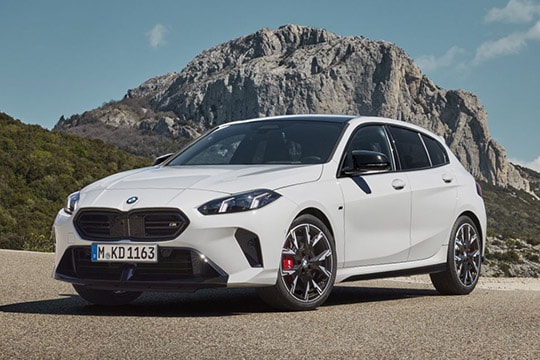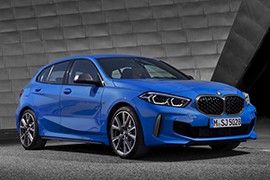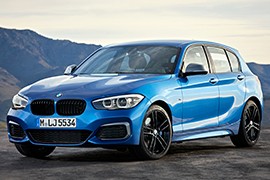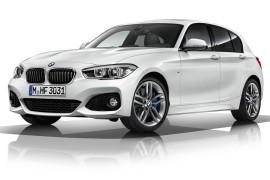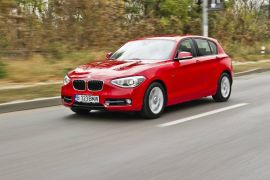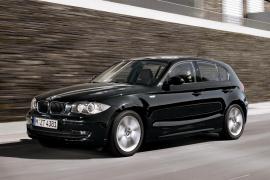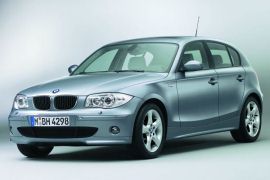BMW 1 Series Models/Series Timeline, Specifications & Photos
First production year: 2004
Engines: Mild hybrid, Gasoline, Diesel
Body style: Hatchback
The fourth generation of the 1 Series saw the broad light in the first days of the summer of 2024, with production and sales starting in October of the same year, and the changes were significant.
It was the second generation to use a front-wheel-drive platform, UKL2, shared with the MINI Countryman and the BMW X1/X2. The German automaker introduced the model during a special event and released it as a five-door hatchback-only affair. It was the first of the 1 Series to sport electrified drivetrains and featured only transversely mounted engines under its hood. While this technical solution was criticized by the brand's hard-core fans, it was still an appealing offer as an entry model in the carmaker's range. It had something for everyone, from those looking for a premium hot hatch to those craving a fuel-efficient vehicle for their daily commute.
Up front, the 2025 BMW 1 Series featured the automaker's new design language. Its angular-shaped, broad upper grille was encircled by a chromed trim for the lower-spec versions, while the M135 fitted with the M-Sport Pro package sported a shiny black one. All versions had received LED lights, with an option for adaptive or Matrix-LED illumination. The lower bumper differed depending on the package, with the lower grades sporting a broad air intake in the apron flanked by small vertical scoops, while the upper trim levels fitted with the M-Sport package and up had a more aggressive look, featuring a chin spoiler and taller side air intakes.
The automaker didn't cheap out when it created the car's profile, installing more expensive but better-looking sculptured doors. They were neatly underlined by body-colored side sills and, depending on the options, by shiny black accents on the door mirror stalks and window surroundings. BMW tried to conceal the transversely mounted engine up front by creating a cab-rearward look for the vehicle. However, the longer front overhang and taller hood revealed the actual technical characteristics of the vehicle. The 2025 BMW 1 Series was fitted with a choice of wheels ranging between 17- and 19-inch alloy wheels, depending on the trims and options. Out back, besides the sportiest model, all versions had concealed exhausts behind the lower side of the bumper that featured a black valance with or without a massive diffuser.
Inside, the automaker offered a plethora of options so that the customers could create their personalized vehicles. Regardless of the version, though, all of them featured the same curved display on the dashboard, where the 10.25" screen fronting the driver was for the instrument panel, while the 10.7" one placed atop the center stack was for the iDrive infotainment system and was touch-sensitive. There were also a few versions for the seats, covered in fabric, Alcantara, or faux leather. The M-Sport versions also had a specific three-spoke steering wheel and a 12-o'clock marking. BMW also offered a sunroof as an option, which could be opened. In the back, legroom and headroom were adequate even for taller people. Behind them
Under the hood, BMW installed a wide choice of diesel and gasoline engines. The 120 and the 120d versions featured 48-volt mild-hybrid technology, which helped customers reduce emissions. At the other end of the scale was the M135 xDrive, which was powered by a turbocharged two-liter gasoline unit that churned out 300 PS (296 hp) sent in all corners. All versions were paired with a seven-speed automatic (dual-clutch) gearbox.
It was a new beginning for the 1 Series, not just because it was the third generation of this nameplate but also because it was redesigned and re-engineered from the ground up.
In 2014, BMW stunned its audience when it introduced the 2 Series Active Tourer model. It was BMW’s answer to premium compact minivans, and in a way, it worked. It was comfortable, roomy, and fuel-efficient. But unlike any other Bimmer in history, it was front-wheel drive. For that car, the automaker created a new platform named UKL2, which was shared with the MINI and with the 2017 1 Series Sedan for the Chinese market. Then, in late 2019, the automaker used the same underpinnings to create the third generation of the 1 Series hatchback, which was available with five doors only. As a result, compared to the first generation that was available in four bodywork versions (5-door hatchback, 3-door hatchback, two-door coupe, and a convertible), the 2020 BMW 1 Series was offered in just one. However, those looking for the sportier version could opt for the 2 Series, which was still an RWD machine, while the regular 1 Series remained a contender in the premium compact segment, fighting with the Audi A3 and the Mercedes-Benz A-Class.
When it introduced the 2019 BMW 1 Series hatchback, the German automaker needed to create a front fascia that could resemble the model’s predecessors. That was a challenging task since the third generation of this moniker had a shorter and taller hood due to the transversely mounted engine. That led to a redesigned front fascia that featured angular, swept-back headlights with C-shaped daytime running lights. Between them, the automaker placed a broad and tall grille, which was not everybody’s cup of tea. However, that worked to conceal the engine compartment’s height. For the lower part of the bumper, BMW offered two options. The M Sport version featured a broad center air intake flanked by slim and vertical vents, which also served for the air curtains, while the standard came with a simpler design. They had a trapezoidal-shaped grille in the middle and large side scoops that housed the fog lamps.
From its profile, the 2019 BMW 1 Series boasted a muscular appearance, with an ascending waistline that crossed the vehicle front to back and ended in the Hofmeister kink shape on the C-posts. In addition, the automaker created sculptured door panels with another ascending creased line. Out back, the raked-forward tailgate featured a roof spoiler at the top, above the raked-forward rear window. The L-shaped LED taillights were extended from the quarter panels to the metallic area of the tailgate to make the 2019 1 Series look wider.
Inside, BMW introduced a fresh dashboard with a design inspired by the one fitted in the 3 Series (the F30). Base models were fitted with analog dials, while the automaker offered an option for a configurable screen placed inside the instrument cluster. In addition, all of the 1 Series had a new touchscreen for the iDrive infotainment system placed atop the center stack. Depending on the grade and options, the 1 Series came with either bolstered seats or sports seats with integrated headrests at the front. In the back, BMW worked hard to provide more knee room and legroom for the rear-seated passengers. Since the car didn’t have the tall transmission tunnel as on the previous 1 Series generations, that was possible. However, the center console’s ending was a bit too intrusive.
Under the hood, BMW had to stick to the inline-three and inline-four powerplants since it couldn’t fit a six-cylinder unit there. As a result, it had to use the turbocharger technology to give the car more power. Depending on the engine version and options, the 2019 BMW 1 Series was available with powerplants ranging between 116 PS (114 hp) and 306 PS (302 hp). Most versions of the car were available with front-wheel drive systems, although selected ones were available with BMW’s intelligent all-wheel drive.
Usually, BMW didn’t make two facelifts for the same car, but it made an exception for the second generation of the 1 Series lineup, which, after a refresh in 2015, got another one in 2017.
There were no significant legislation changes to force BMW to introduce a new range of engines or create additional safety systems to comply with some standards in Europe or elsewhere. However, it tried to keep the last batch of the RWD 1 Series appealing to its customers. While the previous update was significant in terms of styling and engineering, the second LCI (Life Cycle Impulse), the term used by BMW for facelifts, was more subtle. And yet, some essential novelties surprised the brand’s fans.
By 2017 standards, chromed trims started to be out of trend. Customers started to ask for blacked-out decorations, and they even paid extra money to lose all the shiny parts on their vehicles, regardless of the brand. The German automaker noticed that and offered more versions of the 2017 BMW 1 Series 5 doors with a shiny black grille and even dark inserts inside the headlights. These contrasted nicely with the white LED corona lights featuring flat bottoms. The standard apron featured a slim and wide trapezoidal air intake in the middle flanked by a pair of side scoops adorned by a horizontal slat. At the same time, vehicles that were optioned with the M Sport package had a much more aggressive stance. They had a broad air intake in the middle and rectangular scoops to flank it.
From its profile, the 2017 BMW 1 Series 5 doors hatchback didn’t differ too much from its predecessor, albeit there were two new colors available: Sunset Orange and Seaside Blue. In addition, the automaker offered the option for black door mirror caps, which emphasized the car’s sporty character. Furthermore, BMW added five new options for the 17- and 18-inch alloy wheels. In the back, the smoked taillights looked like they came from the tuning community, albeit they were OEM. Their LED stripes contrasted even better with the darker design of the lenses.
Inside, BMW redesigned the dashboard of the 2017 1 Series 5 doors. In addition, it offered new materials for the upholstery and even contrast stitching. A significant improvement was made to the iDrive infotainment system. For the first time in a 1 Series, the automaker installed an 8.8-inch touchscreen atop the center stack. This was a feature demanded by many customers, but the automaker said that the display was too far anyway to be useful. But still, it introduced it. Unfortunately, the automaker couldn’t improve legroom for the rear-seated passengers. They still sat on the same standard 60/40 bench seat with an option for a 40/20/40 split system that could enlarge the trunk space.
Under the hood, the automaker kept the same engine lineup, starting with a mundane inline-three turbocharged powerplant that provided 109 PS (108 hp) paired with a six-speed manual only. Starting with the 118i version, customers could opt for an eight-speed automatic gearbox from ZF. Selected diesel and gasoline powerplants could be fitted with BMW’s xDrive intelligent all-wheel drive system.
BMW 1 Series (F20) LCI 116d 6MT (116 HP)
BMW 1 Series (F20) LCI 116d 8AT (116 HP)
BMW 1 Series (F20) LCI 116d EfficientDynamics 6MT (116 HP)
BMW 1 Series (F20) LCI 118d 6MT (150 HP)
BMW 1 Series (F20) LCI 118d 8AT (150 HP)
BMW 1 Series (F20) LCI 118d xDrive 6MT (150 HP)
BMW 1 Series (F20) LCI 120d 6MT (190 HP)
BMW 1 Series (F20) LCI 120d 8AT (190 HP)
BMW didn’t want to waste too much time, and four years after the unveiling of the second generation of the 1 Series, the F20, it launched a refreshed version of it, and the changes were significant.
Sometimes, automakers refresh their models with minimal aesthetic upgrades, so some needed a keen eye for detail to spot differences. That happened in the previous 1 Series (the E8x generation) when the automaker introduced a new set of bumpers with slightly noticeable changes. However, the Life Cycle Impulse, as BMW likes to call its facelifted models, of the F20 looked almost like a completely new vehicle. Furthermore, changes weren’t limited to the exterior; they were also applied to the interior and, most importantly, under the hood. There, BMW had to update or introduce new engines to comply with the Euro 6 emission standards that were mandatory in September 2015.
The front of the car showed a significant improvement over its non-facelifted sibling. Instead of triangular headlights, the 2015 BMW 1 Series five-door had a pair that resembled those from its bigger brothers, the 3 and the 5 Series, and were available as full-LEDs. In addition, the kidney grille didn’t look that large anymore and was surrounded by a thick chromed rim. The lower side of the bumper was also redesigned. It featured a narrow trapezoidal air intake in the middle flanked by scoops that could integrate the available fog lamps. Furthermore, customers could opt for an M-Sport package with an aggressive look and broader front air intakes in the apron.
From its profile, the changes were less visible but existent. BMW emphasized the ascending creased line that crossed the car from the front fenders to the taillights. Even in its five-door shape, it still looked sporty, especially when fitted with the optional five double-spoke wheels provided by the automaker’s motorsport department, the famous M. Customers could get the 2015 BMW 1 Series 5-door with up to 18-inch alloy wheels, depending on the grade, while base models had 16-inch sets. Out back, the redesigned LED taillights were extended from the quarter panels to the redesigned tailgate. Their L-shaped stripes and horizontal shape made the vehicle look wider.
Inside, there were other significant upgrades as well. For instance, the BMW Connected Drive system went from the previously used CIC to the NBT and was standard across the range. Lower grades came equipped with a 6.5-inch color screen, while an 8.8-inch one was available as an option. The only things that couldn’t be upgraded were the rear passengers’ knee room and the trunk space. Everything else, including materials, features, and amenities, was new or improved.
However, the most significant upgrade happened under the hood. The German automaker retired the N-family of engines, replacing it with the much more improved B-family. The entry-level 2015 BMW 1 Series was powered by a turbocharged inline-three unit that produced a mere 109 PS (107 hp). At the other end of the gasoline-powered versions, the 1 Series boasted a 340 PS (335 hp) twin-turbo B58 unit, which was later installed on other high-performance M vehicles. Diesel fans were not disappointed by the new B47 inline-four turbocharged unit, which produced between 150 PS (148 hp) and 224 PS (221 hp). Besides the entry-level versions, the car was available with either a six-speed manual or an eight-speed automatic that sent the power to the rear or in all corners.
BMW 1 Series LCI (F20) 116d 6MT RWD (116 HP)
BMW 1 Series LCI (F20) 116d 8AT RWD (116 HP)
BMW 1 Series LCI (F20) 116d Efficient Dinamics 6MT RWD (116 HP)
BMW 1 Series LCI (F20) 118d 6MT RWD (150 HP)
BMW 1 Series LCI (F20) 118d 8AT RWD (150 HP)
BMW 1 Series LCI (F20) 118d xDrive 6MT AWD (150 HP)
BMW 1 Series LCI (F20) 120d 6MT RWD (190 HP)
BMW 1 Series LCI (F20) 120d 8AT RWD (190 HP)
BMW 1 Series LCI (F20) 116i 6MT RWD (109 HP)
BMW 1 Series LCI (F20) 118i 6MT RWD (136 HP)
BMW 1 Series LCI (F20) 118i 8AT RWD (136 HP)
BMW 1 Series LCI (F20) 120i 6MT RWD (177 HP)
BMW 1 Series LCI (F20) 120i 8AT RWD (177 HP)
BMW 1 Series LCI (F20) 125i 6MT RWD (218 HP)
BMW 1 Series LCI (F20) 125i 8AT RWD (218 HP)
BMW 1 Series LCI (F20) M135i 6MT RWD (326 HP)
BMW 1 Series LCI (F20) M135i 8AT RWD (326 HP)
BMW 1 Series LCI (F20) M135i xDrive 8AT AWD (326 HP)
BMW 1 Series LCI (F20) M140i 6MT RWD (340 HP)
BMW introduced the second generation of the 1 Series in 2011, continuing to threaten other premium car manufacturers that dared to compete in this segment. But unlike any of them, the Bimmer was the only one in its class with a rear-wheel-drive platform, which was a plus and a minus at the same time.
When Audi introduced the A3 on the market in the '90s, it was almost alone in the segment. Mercedes-Benz had the A-Class, but that was a small-sized MPV, not a hatchback. Then BMW joined the bandwagon with the first generation of the 1 Series in 2004 and changed the rules of the game by introducing the RWD-based small-sized premium vehicle. And, when that wasn't enough, it brought the all-wheel-drive versions into discussion when it launched the second generation of the 1 Series, also known as the F20.
Placing such a big front fascia on a small vehicle was considered not exactly elegant, but BMW knew its customers, and it knew that they wanted to have the kidney-grille large enough to be seen by other drivers in their rearview mirrors. Moreover, the headlights' design followed the same design language as the rest of BMW's range, with narrow inner sides and the famous “angel-eye” daytime running lights inside the headlamps. On the bumper, depending on the version, the German automaker installed a set of air intakes on the sides where the fog lamps were fitted. From its sides, the cab-rearward design was obvious thanks mostly to the long and low hood, made to accommodate inline-six engines underneath it. The sculptured door panels featured an ascending line that started from the front wheels and emerged onto the C-pillars. Finally, at the back, the automaker created a tilted forward tailgate adorned with a small roof spoiler on top. Depending on the engine version, underneath the rear bumper, BMW installed a twin or a single exhaust pipe.
Inside, the best seats in the house were at the front. Even the base models featured bolstered seats, and the automaker offered the F20 with a set of high-bolstered ones in the M-Package, which featured adjustable lengths and high-bolstered areas. In front of the driver, the dashboard design was simple and clear, with two dials for the tachometer and speedometer and two smaller ones for the fuel level and engine temperature. On the center stack, again, depending on the options, BMW placed the screen for the infotainment unit that could've been controlled via the rotary knob housed by the center console. In the back, there was hardly enough legroom for three rear passengers, especially since the transmission tunnel crossed the car from front to back.
Under the hood, BMW installed a wide engine range, either gasoline or turbodiesel. These were paired with six-speed manuals or, as an option, with an eight-speed automatic. Depending on the engine version, the car promised excellent fuel efficiency and plenty of fun behind the wheel.
BMW 1 Series (F20) 114d 6MT RWD (95 HP)
BMW 1 Series (F20) 116d 6MT EfficientDynamics RWD (114 HP)
BMW 1 Series (F20) 116d 6MT RWD (114 HP)
BMW 1 Series (F20) 116d AT RWD (116 HP)
BMW 1 Series (F20) 118d 6MT RWD (143 HP)
BMW 1 Series (F20) 118d 8AT RWD (143 HP)
BMW 1 Series (F20) 118d xDrive 6MT AWD (143 HP)
BMW 1 Series (F20) 120d 6MT RWD (185)
BMW 1 Series (F20) 120d 8AT RWD (184 HP)
BMW 1 Series (F20) 120d xDrive 6MT AWD (184 HP)
BMW 1 Series (F20) 114i 6MT RWD (102 HP)
BMW 1 Series (F20) 116i 6MT RWD (136 HP)
BMW 1 Series (F20) 116i 8AT RWD (136 HP)
BMW 1 Series (F20) 118i 6MT RWD (170 HP)
BMW 1 Series (F20) 118i 8AT RWD (170 HP)
BMW 1 Series (F20) 125i 6MT RWD (218 HP)
BMW 1 Series (F20) 125i 8AT RWD (218 HP)
BMW 1 Series (F20) M135i 6MT RWD (320 HP)
BMW gambled a lot when it launched the first generation of the 1 Series in 2004, but the sales results were satisfying, so in March 2007, it unveiled the refreshed version of the car at the Geneva Motor Show.
After two generations of the 3 Series Compact, the German automaker understood that customers couldn’t be tricked with a shortened version of an existing vehicle based on an older platform. As a result, it started from a blank sheet of paper and created the 1 Series, also known as the E87, the factory coding for the five-door version. Sales went straight through the roof, and in just three years, the new model had exceeded the overall sales of the 3 Series compact in its seven-year production run. Then, the automaker considered expanding the range and added a three-door version along with the facelift for the five-door 1 Series.
There were slight differences between the 2007 BMW 1 Series five-door and the non-facelifted version of the car. However, a keen eye for detail could notice them on the front grille, which sported rounded upper outer corners instead of sharper ones. Furthermore, the bumper had a different apron featuring a broad air intake extended from side to side, comprising the available rectangular fog lamps. In the 2004 model year, the lower air intake was shorter, had rounded shapes, and was flanked by round fog lamps. In addition, the new version was available with a more aggressive styling inspired by the BMW M3, featuring a broad and tall center low air intake and angular-shaped side scoops.
At first sight, there were no differences between the profiles of the 2004 1 Series and the 2007 model year. However, the creased line that visually connected the front fenders to the taillights was sharper and emphasized the car’s sporty character. Even though its five-door shape didn’t look that dynamic, it was a sweet compromise between a hot hatch and a car that could easily carry four people around. Out back, the tailgate with its tilted-forward windshield was adorned at the top by a roof spoiler. It was flanked by new taillights with the same shape as the previous ones, albeit they sported two smaller clear lenses instead of one thick one as before. Last but not least, the smoothed-out bumper made the car look wider.
Inside, the new interior received higher-quality materials for the dashboard and trims. Like its predecessor, the 2007 BMW 1 Series (E87) was available with leather-wrapped sports seats, while the lower grades had mild-bolstered bucket seats with cloth upholstery. Atop the dashboard, the automaker offered a swiveling screen option for the iDrive infotainment system that could be controlled via a rotary dial placed on the center console between the front occupants. In the back, legroom was still limited, and due to the tall transmission tunnel, it was very challenging to sit three occupants there, especially if they were adults. Thanks to the split-folding bench seat, customers could create a larger trunk space.
Under the hood, the 2007 BMW 1 Series five-door (E87) had improved engines over the 2004 model year. These were already Euro 5 compatible, an emission standard due to enter in 2009. Furthermore, the automaker also introduced more potent inline-six engines that transformed the otherwise mundane-looking 1 Series into a pocket rocket. Customers could get the car with a six-speed manual or a six-speed automatic, with all the power sent to the rear wheels only.
Audi dominated the premium compact hatchback segment, and BMW decided to end that when it introduced the first generation of the 1 Series in 2004, hoping to attract more customers to its showrooms.
BMW tried to sell a shortened version of the 3 Series Compact for two generations, and the results were not very satisfying, to say the least since the car manufacturer ditched the model. Meanwhile, the automaker’s engineering team was busy trying to find a better alternative for that, and they created the 1 Series. It was a hatchback that didn’t share its platform with any other vehicle on the automaker’s lineup until later when the E90 and the first generation of the Z4 roadster came around. The idea behind this model was to provide customers with a more affordable Bimmer with a rear-wheel drive setup and upscale features unavailable on most other cars in the same market segment.
The E87, as it was known in the factory coding, was introduced in late 2004 at the Paris Motor Show and was designed by Chris Chapman. He created a controversial-looking front fascia that followed the ideas introduced by Chris Bangle on BMW’s lineup. The clear lenses covered the dual headlamp units of the headlights, which were swept back towards the sides of the vehicle and also covered the turn signals. They flanked the classic kidney grille that was part of the wrapped-around plastic bumper. Lower, in the apron, the stylist created a smiling shape for a broad center air intake that could be flanked by available round fog lamps.
From its side, the 2004 BMW 1 Series was available exclusively as a five-door hatchback affair. It featured a short nose compared to the 3 Series, even though it shared its inline-six engines with that lineup. The cabin was pushed rearward with a panoramic windshield followed by a short, arched roof. To create a sloped-down look for the vehicle, Chris Chapman made the upper side of the rear doors arched downward but kept the Hofmeister kick on the C-pillars. At the back, the almost vertical tailgate was flanked on its mid-section by corner-mounted taillights featuring horizontal reversing lights with clear covers in the middle. Thanks to this styling tweak, the car seemed wider than it was. On the lower side of the rear fascia, the automaker installed a wrapped-around plastic bumper with a lower valance that allowed the exhaust (single or twin) to peak out.
Inside, the 2004 BMW 1 Series (E87) had a cozy interior fit for four occupants. At the front, depending on the grade and options, there were either fabric-covered seats with mild bolstering or bucket seats that promised to keep their occupants in place during high-speed cornering. On the bright side, it was available with leather upholstery. In the back, legroom was nothing to write home about. Fronting the driver was a small-sized and rounded instrument cluster filled with two large dials for the tachometer and speedometer. On the lower side of the latter, the automaker squeezed the fuel level gauge. Surprisingly, the car didn’t have the instant fuel consumption indicator like any other BMW from that era. Furthermore, there was no temperature indicator, only a bulb that was blue when the engine was cold and turned off when it was warm enough. Among other upscale amenities, the E87 was available with an iDrive infotainment system that also featured navigation.
Under the hood, the automaker installed a choice of straight-four or straight-six, gasoline or turbodiesel engines. Indeed, it was the only compact-segment five-door RWD vehicle to boast a six-cylinder unit. It was paired with either a five- or a six-speed manual, with an available six-speed automatic, depending on the powerplant.
